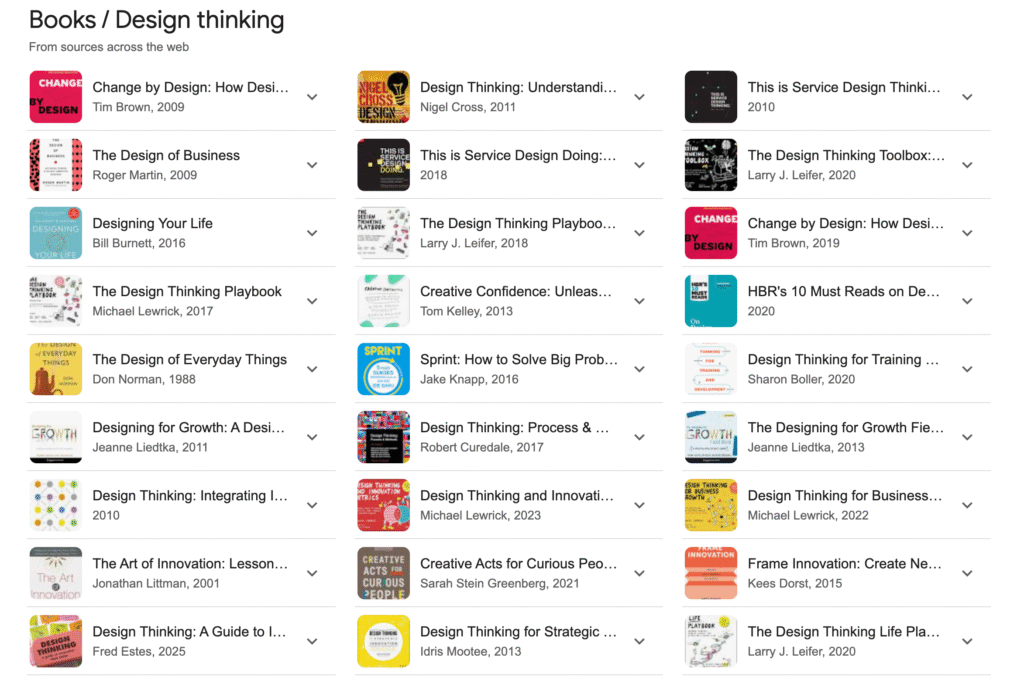If you want to understand why Design Thinking became a real revolution for designers, entrepreneurs, and leaders, let’s start with the most popular design thinking book — and then break down the method itself: why it matters, how each stage works, and which books about design thinking are truly worth having on your shelf.
But fair warning — this won’t be another dry list. It’s an honest conversation (with a bit of provocation). Because if the method stays trapped in PowerPoint slides, “five-step” diagrams, and phrases like “we’re user-centered,” then it stops being a powerful tool and turns into corporate theater.
The Best Design Thinking Books — From Classics to Hidden Gems
Let’s start with what’s considered the most popular design thinking book today — and move down the list from there.
The ultimate classic, according to experts and schools like Stanford d.school, is The Design of Everyday Things by Don Norman. It’s not exactly a “design thinking manual,” but it’s where everything began. Norman explores design as a conversation between the object and the user — if something feels confusing, it’s not your fault as a user, it’s the designer’s. This book is pure gold if you want to understand the roots of human-centered design.
Next comes The Design Thinking Toolbox by Michael Lewrick, Patrick Link, and Larry Leifer — a hands-on guide packed with practical tools, frameworks, and exercises. If Norman gives you philosophy, this one gives you action.
Then there’s Design Thinking for Strategic Innovation by Idris Mootee — written for business leaders. It’s about using design thinking not just as a process, but as a strategic mindset that drives innovation and leadership.
You should also check out Graphic Design Thinking by Ellen Lupton — a fresh perspective on how design thinking applies to visual communication and graphic design.
And finally, This Is Service Design Thinking — a must-have if you work with services or customer experiences, not just digital or physical products.
Each of these books deserves a spot on your shelf — but they focus on different things:
-
Want to understand what design thinking is? Start with Norman.
-
Want to apply it in practice? Go for The Toolbox.
-
Want to use it in business? Pick Mootee.
-
Focused on visual design? Read Lupton.
-
Working with services? Choose This Is Service Design Thinking.
This sequence moves from a broad understanding of design, through the methodology of design thinking, into strategy, and then into visual communication and service design.
From there, you can go even deeper into specialized areas — design thinking in education, social innovation, healthcare, sustainability, and even government policy. Each field adapts the same core mindset — empathy, experimentation, and systems thinking — but applies it to very different human challenges.
That’s the beauty of design thinking: it’s not limited to apps or products. It’s a universal framework for solving problems — whether you’re redesigning a classroom, improving hospital experiences, or reshaping entire organizations.
Drawbacks? Sure. Classics can feel a bit outdated. Business-focused books sometimes talk too much about theory and not enough about execution. Visual ones can lack depth in methodology. But that’s exactly why you need a library, not just one book. Each author opens a different door into the same creative universe.
What Is Design Thinking — and What Problems Does It Solve?
Design Thinking is not just “think first, build later.” It’s a human-centered approach to solving complex, even messy (“wicked”) problems through empathy, iteration, and constant testing. It’s less about creating a perfect plan — and more about learning through doing.
At its core, design thinking helps teams look beyond the obvious. We often try to fix the wrong thing. For example, a bank might want to “increase online loan applications,” but the real issue isn’t the form — it’s trust. Users hesitate not because the interface is bad, but because they don’t feel safe sharing their data. Design thinking uncovers that hidden layer.
It also connects three essential elements:
-
What people truly desire (human needs)
-
What’s technically possible (feasibility)
-
What’s viable for business (profit and sustainability)
When those three meet — that’s where innovation happens.
Design thinking pushes teams to work fast, cross-functionally, and empathetically. Instead of waiting for the perfect solution, they prototype, test, and iterate — over and over again.
Here’s a real-world style example: You’re an Uber driver and you notice many passengers cancel rides because they feel uncertain — about the car, the route, or the driver. Instead of just tweaking the app interface, you ask a deeper question:
“How can the ride feel trustworthy from the moment it’s booked until the passenger arrives?”
That’s empathy. That’s re-framing the problem.
You define it: “Passengers cancel because they fear the unknown — who’s coming, when, and how safe it is.” Then you generate ideas — a short video intro from the driver, live route tracking, instant voice feedback from past riders. You prototype, test, improve.
That’s design thinking in action — not theory, not slides, but a living creative process that connects humans, tech, and trust.
Key Areas Where Design Thinking Shines
Service Design — when the focus is on designing a service, not just a product. It’s about understanding how a customer interacts with your brand, what emotions they experience, and how every touchpoint builds trust and value.
Social Innovation — where problems are complex, human, and deeply interconnected. Design thinking helps teams tackle challenges like behavior change, community development, and improving quality of life. It’s used by NGOs, governments, and startups working toward meaningful social impact.
Digital Products and UX/UI Design — this is where design thinking meets user experience. It helps designers go beyond “pretty interfaces” to craft intuitive flows, accessibility, and emotional resonance.
Corporate Transformation and Business Models — many companies now use design thinking to stay competitive and human-centered. It drives innovation, builds empathy inside teams, and helps organizations redesign their culture from the inside out.
Education and Learning Design — one of the most powerful applications. Design thinking helps educators create learning journeys that are engaging, adaptive, and built around real student needs. From curriculum design to online platforms, it changes how we think about learning itself.
Why You Should Own These Design Thinking Books
Each of the books above isn’t just a “nice read” — it’s an investment in how you think.
Too many designers and managers still treat design thinking like a checkbox in a PowerPoint deck — “Yes, we’re doing design thinking” — and then go right back to old habits: long meetings, heavy specs, endless approvals.
But design thinking is not about rituals — it’s a revolution of mindset. It’s what separates teams that truly innovate from those that just redesign buttons.
If you want to do more than just “make an app” — if you want to solve real human pain points, change the way people experience the world, and create solutions that actually matter — then these design thinking books belong on your shelf.
Mastery doesn’t come from theory alone. It comes from reading, practicing, failing, and iterating — exactly what design thinking itself teaches you to do.
So don’t just read about it. Live it. Test it. Break it. Improve it. That’s what great design thinkers do.
Remember the scene in The Founder where the McDonald brothers drew the kitchen layout with chalk on a tennis court and acted out the cooking process? That’s design thinking in action: observing, testing, iterating, and showing empathy. They didn’t write strategies — they put themselves in the cooks’ shoes and figured out how to make the workflow faster and easier. Watch this clip — it explains real user-centered thinking better than any textbook.

